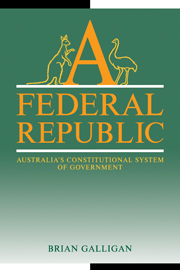Book contents
- Frontmatter
- Contents
- Tables and figures
- Preface
- Dedication
- Introduction
- 1 A federal republic
- 2 Federal theory and Australian federalism
- 3 The Senate and responsible government
- 4 Labor and the Australian Constitution
- 5 The referendum process
- 6 The protection of rights
- 7 The High Court and the Constitution
- 8 Intergovernmental relations and new federalism
- 9 Fiscal federalism
- 10 Towards and beyond 2001
- Bibliography
- Index
3 - The Senate and responsible government
Published online by Cambridge University Press: 05 November 2011
- Frontmatter
- Contents
- Tables and figures
- Preface
- Dedication
- Introduction
- 1 A federal republic
- 2 Federal theory and Australian federalism
- 3 The Senate and responsible government
- 4 Labor and the Australian Constitution
- 5 The referendum process
- 6 The protection of rights
- 7 The High Court and the Constitution
- 8 Intergovernmental relations and new federalism
- 9 Fiscal federalism
- 10 Towards and beyond 2001
- Bibliography
- Index
Summary
Despite its awesome constitutional powers and periodical championing by those promoting rejuvenation of parliament, the Australian Senate remains the Cinderella institution of Australian government. For almost a century it has been overshadowed by a combination of responsible executive government and disciplined party politics. Responsible government, which locates the executive in the House of Representatives, has ensured the primacy of that chamber, while disciplined parties have extended the party divide into the Senate. Adoption of proportional representation as the electoral method for the Senate in 1949 fostered the emergence of minor parties and independents able to arbitrate between the major parties. This has given a fillip to the Senate and produced periods of stormy confrontation between the two houses of parliament. The most notable was in 1975 when the Senate refused to pass the government's supply bills and an assertive governor-general, Sir John Kerr, sacked the Whitlam Labor Government to break the deadlock. More recently, a Senate in which the balance of power was held by seven Australian Democrats, two Greens from Western Australia and a Tasmanian independent has forced the Keating Government to make significant changes to its most important legislation, the 1993 budget and Mabo legislation establishing a national system for processing native title land claims. Hence the Senate's powers and the way it harmonises with responsible government are again a matter of intense public controversy.
- Type
- Chapter
- Information
- A Federal RepublicAustralia's Constitutional System of Government, pp. 63 - 90Publisher: Cambridge University PressPrint publication year: 1995



